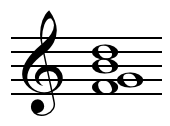Harmony/Chord Inversions
Inversions of Triads
[edit | edit source]Earlier in the course, it was discussed how triads are based on a root note that is part of the key. Inversions occur when the root note is not at the bottom of the chord.

Root Inversion
[edit | edit source]Root inversion chords are the ones we are familiar with from earlier on. The root note is in the bass. This is typically easy to see, as all the notes in a triad are touching (3rds apart). In numerals, root inversion is denoted with the appendage 'a', although often this is left out as a chord is presumed to be in root inversion unless stated otherwise.
Root inversion chords sound the strongest, as the root note of the chord sounds more prominently. In a typical piece of music, a majority of the chords are likely to be in root inversion.
1st Inversion
[edit | edit source]A 1st inversion chord is one where the third is in the bass. This can be seen by the gap between the fifth and the root note (an interval of a 4th rather than a 3rd). In numerals, 1st inversion is denoted with the appendage 'b'
1st inversion chords sound strong, but a little weaker than root inversion chords.
2nd Inversion
[edit | edit source]A 2nd inversion chord is one where the fifth is in the bass. This is seen by the gap between the fifth and the root note (a 4th). In numerals, 2nd inversion is denoted with the appendage 'c'
2nd inversion chords usually sound the weakest. As such they are not used as often in conventional harmony except for certain cadences and modulations.

3rd Inversion and Other Inversions
[edit | edit source]3rd inversions and others arise when you have more than just a triad, and one of the added notes is in the bass. 3rd inversion refers to the 7th in a 7th chord being in the bass. There are theoretically many more inversions for extended chords, although this is uncommon. In numerals, 3rd inversion is denoted with the appendage 'd' - again, theoretically, this system continues for as many inversions as is needed to describe the chord.
3rd inversion has a sense of tension to it, which is why chords such as Vd are often used near cadences.
Further Work
[edit | edit source]
It is important that you can identify inversions of chords when you see them written down. As such, it is worth looking at different manuscripts and trying to identify which chord is being used, and in what inversion.
